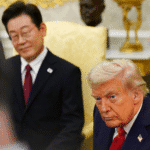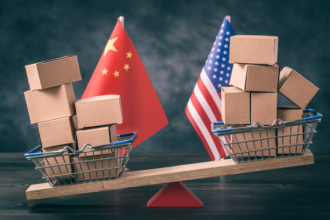The jump in U.S. tariffs has brought altogether unpleasant disturbances to the Indian-US trade leaving major export hubs of India like Tiruppur, Surat, and Mumbai in turmoil. As a 50 percent tariff on critical Indian imports goes into effect, thousands of companies are routinely suspending activities, putting expansion plans on hold, and experiencing an ever-increasing degree of uncertainty.
India ships to the United States billions of textiles, gems, and, shrimp to the United States. Nevertheless, the recent sanctions on trade have aroused the sense of urgency (as well as punishments on trading Russian oil and defense). Most factories are left idle, inventories unsold and exporters do not know how to pay their workers or to maintain their operations.
Is Tiruppur’s Garment Industry Reeling From New Trade Policy?
At Tiruppur, Tamil Nadu, one of the major production centres of ready to wear products, the effect of the new Indian US free trade policy is felt. The factories are running at far little capacity. Orders placed by United States retailers have been put on hold and seasonal deliveries particularly those destined to cater to the Christmas market are left unfinished.
Garment manufacturers that have recently expanded or contracted new personnel, are an example of how they are treading back. One unit that had hoped to hire 250 workers has instead bench them. The profit margin introduced through the tariff results in Indian shirt prices that increased in the U.S. by 1.64 to 16.40 dollars, which make it less competitive against shirts that are produced in Bangladesh, China, or Vietnam.
With the Diwali season in India, exporters are turning their attention to the domestic market in the country in the hope of remaining solvent. Here is the link to our article on Trade Powers Partnership.
What is going on in the Diamond Industry?
Surat, Gujarat, which produces the biggest diamond polishing market in the world, has been losing out to falling globally. The new tariffs have now further made matters worse in the crisis.
The operating day is only 15 days out of a month where as they used to run the factory round the year. Those cut directly have declined and monthly production has decelerated to a drastic result of 300 polished diamonds in specific units.
The bank margins within this sector are already painfully thin, accounting to only 3-4% threshold and they cannot absorb costs generated by the India-US trade collapse. This action resulted in thousands of contract workers being put on unpaid leave as well as units owners trying to reduce operational expenses as much as they can.
Is there a Collapse of Shrimp Exports?
India leads the list as largest shrimp exporters in the world with the United States being the main consumer. Raising tariffs on shrimp to more than 60% have brought the industry to its knees.
Since the announcement, prices have dropped as follows, up to 0.72 per kilogram. Agriculturalists are confused and they are yet to cultivate. Hatchery operators have scaled the production of the shrimp larvae by almost 40 percent in the fear of inability to find buyers.
This individual policy change can jeopardise the livelihoods of almost three million Indians, half a million of whom are farmers, and another 2.5 million associated with their livelihoods by logistics, processing and supply. Here is the link to our article on Trade Boosts Relations.
What Implications Does this Have on the Trade approach of India?
The sideswipe effect of this sudden twist in India-US trade relations is beginning to be felt. An emerging trade agreement is no longer happening. The new round of negotiations at the end of July was canceled in New Delhi.
In the meantime, American authorities have been more critical of India as they have accused the Indian nation of serving Russia and its interests. This has poisoned the foreign relations more.
India has initiated the process of exploring alternative markets by partnering up with the UK and Australia. Moreover, short term actions such as waiving tariff of raw materials have been implemented. Nevertheless, many are convinced that such measures will not help to overcome the extent of disruption that is currently in motion.
Final Thoughts
India-US trade has shifted radically and this has set an ensuing effect to its export economy. Through garment hubs, shrimp farms and diamond units, the effect is far-reaching and acute. Although there is ongoing effort to achieve diversification of trade partners, the future is not clear yet. The way ahead in India will require resilience, strategic rebalancing, and rejuvenated effort towards economic self-reliance on the part of the policymakers.








